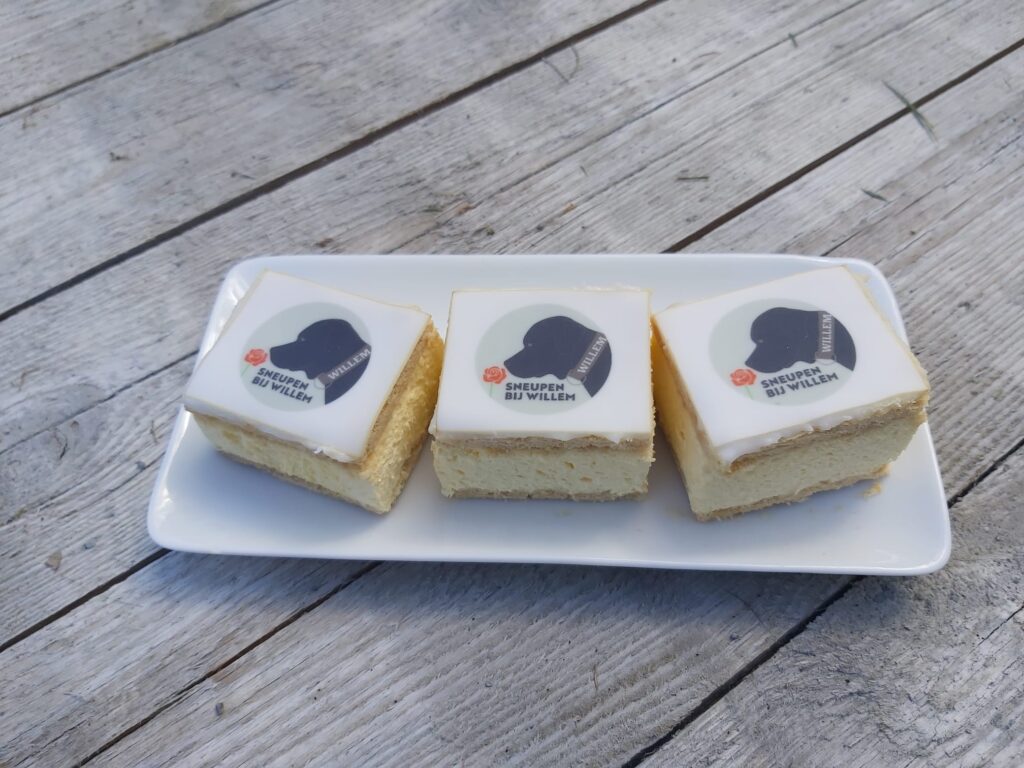
![]() 𝟐𝟎𝟐𝟐 – 𝟐𝟎𝟐𝟓
𝟐𝟎𝟐𝟐 – 𝟐𝟎𝟐𝟓
Liters of tea (and sometimes a cup of coffee), always with something sweet on the side
Deep conversations and precious moments
Wandering, exploring, sniffing
Strolling, searching, snacking
Discovering and daring, feeling safe
Emotions, admiration, and wonder
Curiosity and engagement
Sniffed, explored, and slobbered over
Young, old & a little older
Trust, personal choices, and control
Stimulating all five senses
Enrichment, freedom
Foundation of ‘Sneupen bij Willem’ established
Learning and sharing knowledge
Help and valuable insights
New friendships
Lots of laughter, sometimes with a tear
Leisure time, support and donations for animal charities
350+ dogs who became part of this adventure
That is the power of the Sensory Garden!
These were three special years of Sensory Garden Sneupen bij Willem
To all visitors: a big thank you and see you soon!
Here’s to many more years of Sneupen bij Willem ![]()
![]()
𝐀 𝐬𝐩𝐞𝐜𝐢𝐚𝐥 𝐭𝐡𝐚𝐧𝐤𝐬 𝐭𝐨 𝐦𝐲 𝐝𝐞𝐚𝐫𝐞𝐬𝐭 𝐥𝐨𝐯𝐞, 𝐑𝐞𝐧𝐞́—𝐰𝐢𝐭𝐡𝐨𝐮𝐭 𝐲𝐨𝐮, 𝐈 𝐜𝐨𝐮𝐥𝐝 𝐧𝐞𝐯𝐞𝐫 𝐡𝐚𝐯𝐞 𝐦𝐚𝐝𝐞 𝐭𝐡𝐢𝐬 𝐝𝐫𝐞𝐚𝐦 𝐜𝐨𝐦𝐞 𝐭𝐫𝐮𝐞 ![]()
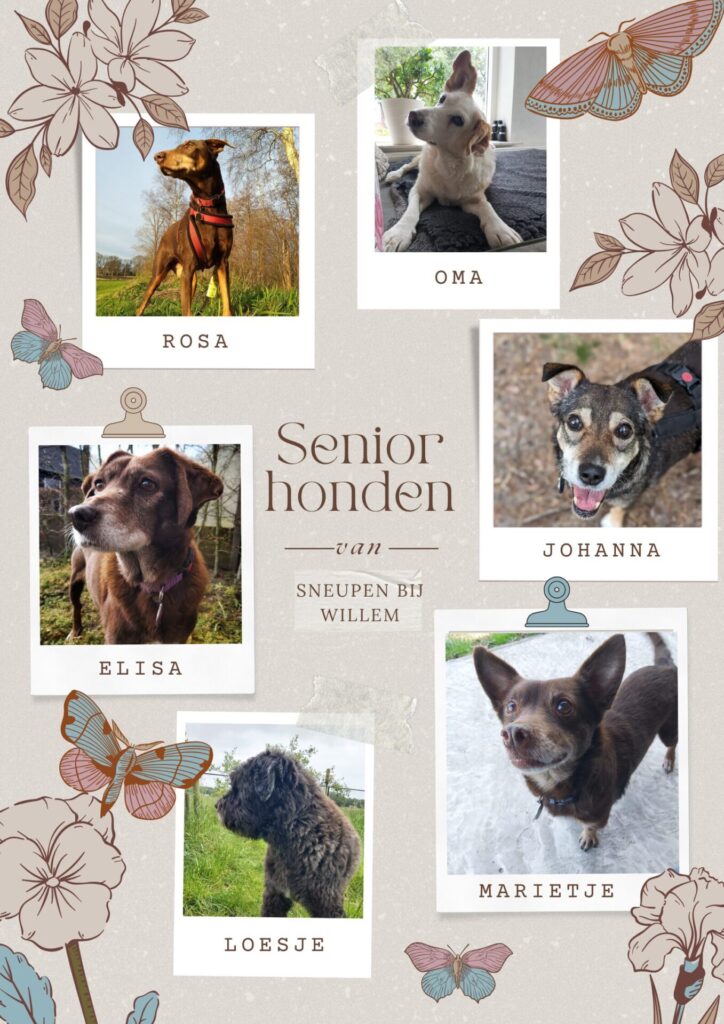
“I wouldn’t be able to do it!”
“I really couldn’t do that!” “What’s the point of adopting an old dog?” Phrases we hear all too often. My answer? Letting them know they are wanted, loved, and truly welcome. Nothing more, nothing less.
Over the years, we’ve had the privilege of adopting several older ladies and giving them a wonderful time—a warm autumn of their lives. Is it always easy? No. Often with a smile, sometimes with a tear. Because every dog carries its own history: from abuse and neglect to starvation, roaming the streets, or being locked away for years. Sometimes it’s simply bad luck—a former owner who can no longer care for them or has passed away.
We can’t erase that past. But what we can do is offer a new beginning, with peace, space, routine, freedom, and the right medical care. And then something magical happens: an elderly dog blossoms, rediscovers joy, almost frolics like a puppy again.
And that is why we do this.
“What’s the point of adopting an old dog?” Just love them. And cherish every moment.
Perhaps this resonates with you. Have a look at the senior dogs available for adoption—maybe your new friend is waiting there.

FOR WHOM AM I WALKING?
The first week or three that our dog OMA was here, we first let her quietly get used to us, our house, our yard, our animals. Step by step, at her pace, she could discover and get to know everything. That actually went very smoothly, very naturally. She could do her business on our property, so there was no need to walk outside.
After those first weeks, she showed more interest in the world outside the gate, and we decided to put her on a leash and go for a walk. We have a nice sandy path in front of the door, ideal for exploring. Again, step by step, at her pace. 50 meters became 100 meters, 100 meters became 200 meters, and so on. Until I soon noticed that the distances became shorter again, she preferred to go back home, to her familiar environment.
Then I realized, for whom am I walking? Does she need to walk? Isn’t it sad to just stay on the property and wander around there? Is she missing out on anything?
The answer was no. OMA is retired here, she doesn’t have to do anything and enjoys every day to the fullest. Sometimes she still wants to go a bit on the path, sniff who has been there, and that’s fine. But if she doesn’t want to, that’s also fine 😊.
The above text is written about our dog OMA (13.5 years old), but of course, it applies to every dog. Regardless of age. Look and listen to your dog to see what he/she tells you.
In memoriam: OMA (born ESP 2010) , home 2021-2024
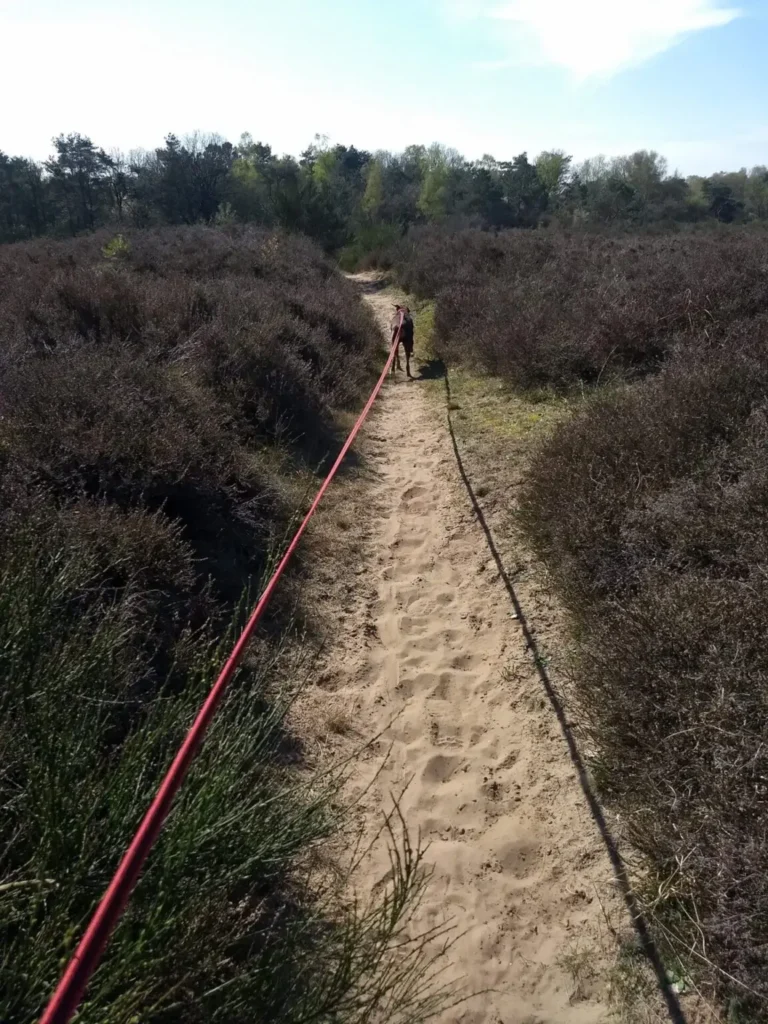
OFF-LEASH OR ON-LEASH?
With Rosa, it wasn’t really a question; it was clear: on-leash!
With ears that didn’t work (deaf), eyes that didn’t work well (cataracts), and a nose that was always on, we didn’t think it was responsible to let her walk off-leash outside our fenced property.
The risks were too great. She could wander off, get hit by a car, get lost, etc. etc. But also because she reacted to everything that moved, we couldn’t take the risk. Not safe for others who happened to cross our path and not safe for her.
Because our other dog Willem always walked off-leash, we had to get used to it together, but with a well-fitting harness and a long 5 or 10 meter leash, she could move around and explore the world just fine. A win-win situation for everyone.
So, if off-leash is possible and safe for everyone, fine. If not, take responsibility, buy a nice harness + long leash, and walk. Rosa passed away at the end of 2020 after being with us for over 2 years. Now she makes the eternal hunting grounds unsafe, off-leash.
In memoriam: Rosalia (born GR 2006), home 2018-2020
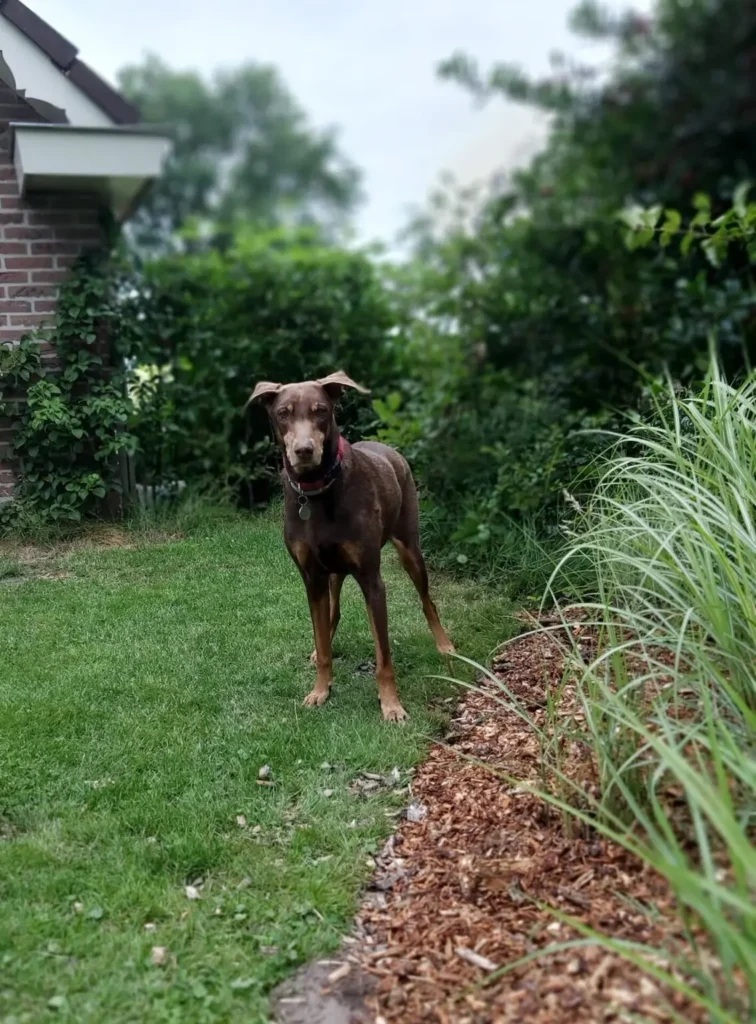
LIMITATIONS DON’T ALWAYS HAVE TO BE LIMITATIONS
When we adopted Rosa in October 2018, we were informed in advance that she was an elderly lady with a heart problem. Something for which she needed daily medication.
Since that was not a limitation for us, we didn’t see it as a problem.
After a long journey from Greece, we could pick her up and get to know this beautiful lady. First, let her catch her breath, relieve herself, and of course, give her some water.
Then another car ride to the High North of the country, and she was home. Right away, we noticed she was “different,” but her world had also changed quite a bit in the past days. The next day, it became clear: she was deaf, but also visually impaired. We hadn’t taken that into account. OK. Was it a problem, a limitation? No, at most an adjustment on our part. She always kept a good eye on us, so sign language was something we grew into together. We found off-leash walking risky, but with a harness and 5-meter leash, she could move around just fine.
But what still worked excellently? Of course, her nose! We took her on daily sniffing walks in the woods and introduced her to mental exercises. She loved it, it was so beautiful to see. After a few weeks, when she felt completely at home and settled, we introduced something new: practical tracking. Another whole new experience. She quickly got the hang of it and off she went, looking for the “missing person” in the woods. So proud of our little chick Rosa.
So some (unexpected) limitations don’t always have to be limitations. At most, just some thinking outside the box and adjustments.
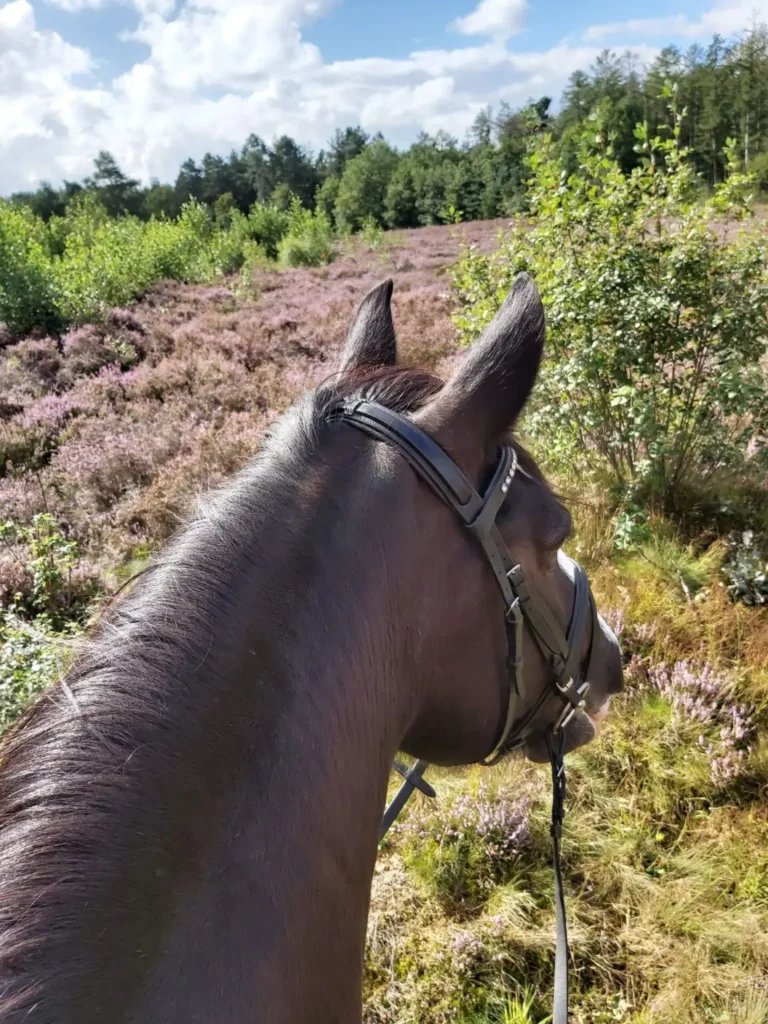
THE 50/50 RULE
Since childhood, I’ve been a true horse girl. When I was 5 years old, I was infected with the “horse virus” and luckily, it never went away. Like all other horse girls, I had a big dream: owning my own horse! Fortunately, my parents were wise enough not to buy one for me. I was too young to take responsibility for my own horse, too busy with school, homework, and friends, and they also found it very important that I saw there was more to life than just horses.
The most important advice they gave me was the “50/50 rule.” This rule means that to keep animals, no matter how small or large, you need both ENOUGH TIME and ENOUGH MONEY. If one of the two is missing now or in the near future, you shouldn’t get started. They had a point, even though I didn’t think so at the time.
In 2015, we moved from the Randstad to Friesland, to a small farm in a rural area with our own horses at home and a few cats and chickens. The best decision ever.
That was the moment when my second dream could come true; owning my own dog! We adopted a puppy, Rottweiler Willem. When he turned 3 years old, we decided to get another dog. The 50/50 rule still applied. Because we wanted to give older animals a good retirement, we chose Greek Rosa. After her passing, Spanish OMA came into our lives.
Daily, I see stories of people with dogs who haven’t thought well about the rule my parents used. They impulsively bought a dog, nice for the children, etc. Due to Corona, many people suddenly started working from home, which meant they had the space to give a lot of attention at that moment. Now that the situation is changing again, it seems there is “suddenly” no time anymore. Besides the lack of time, I also regularly see animals being denied (medical) care. There is not enough budget for the vet, medication, or other additional care.
At such moments, I am glad that my parents ensured I always think very carefully about getting a new animal. Animals cost a lot of time and money, you have to realize that and be able to afford it. We knew Rosa had a heart problem and needed medication for it. This amounted to 2 euros per day. It turned out that OMA also needs medication, about 3 euros per day.
We regularly receive requests for animal shelter. Only if it doesn’t conflict with the animals already living here and if it fits within the 50/50 rule, will we consider it. Otherwise not.
PS: I bought my first own horse when I turned 40, beautiful Avalon.

I came across this video by Movement Educator Joël Kruisselbrink from “Leven is bewegen” (on Instagram):
https://www.facebook.com/reel/429461796322387
“Activating Playfulness:
Playfulness not only promotes physical health but also mental, social, and emotional well-being, thereby improving the quality of life.”
What does this have to do with dogs and the Sensory Garden?
Well, everything actually.
No matter how old your dog is, there is always something you can think of that you can both enjoy and have fun with.
For older dogs, it’s important to sometimes relieve the body a bit more, but still keep stimulating the brain.
You can easily get dogs moving in a low-threshold way with household, garden, and kitchen items, enrich their enviroment.
And the advantage of the dog’s nose—it always works. The options are endless: visiting Sensory Gardens, sniffing walks, brain games for dogs, detection, practical tracking, food enrichment (lick mats, ditch the bowl), etc. etc.
Look at what your dog can still do instead of what he/she can no longer do and enjoy. Older dogs are cool.

IN SILENCE
https://youtu.be/TzgqyPMv7Tk?feature=shared
Video, Canine Arthritis Management
2.5 minutes

Petting a dog? Ask first!
You don’t need to touch a dog
to make contact with them.
Sometimes it is just space what they want, not affection
no matter how good your intentions are.
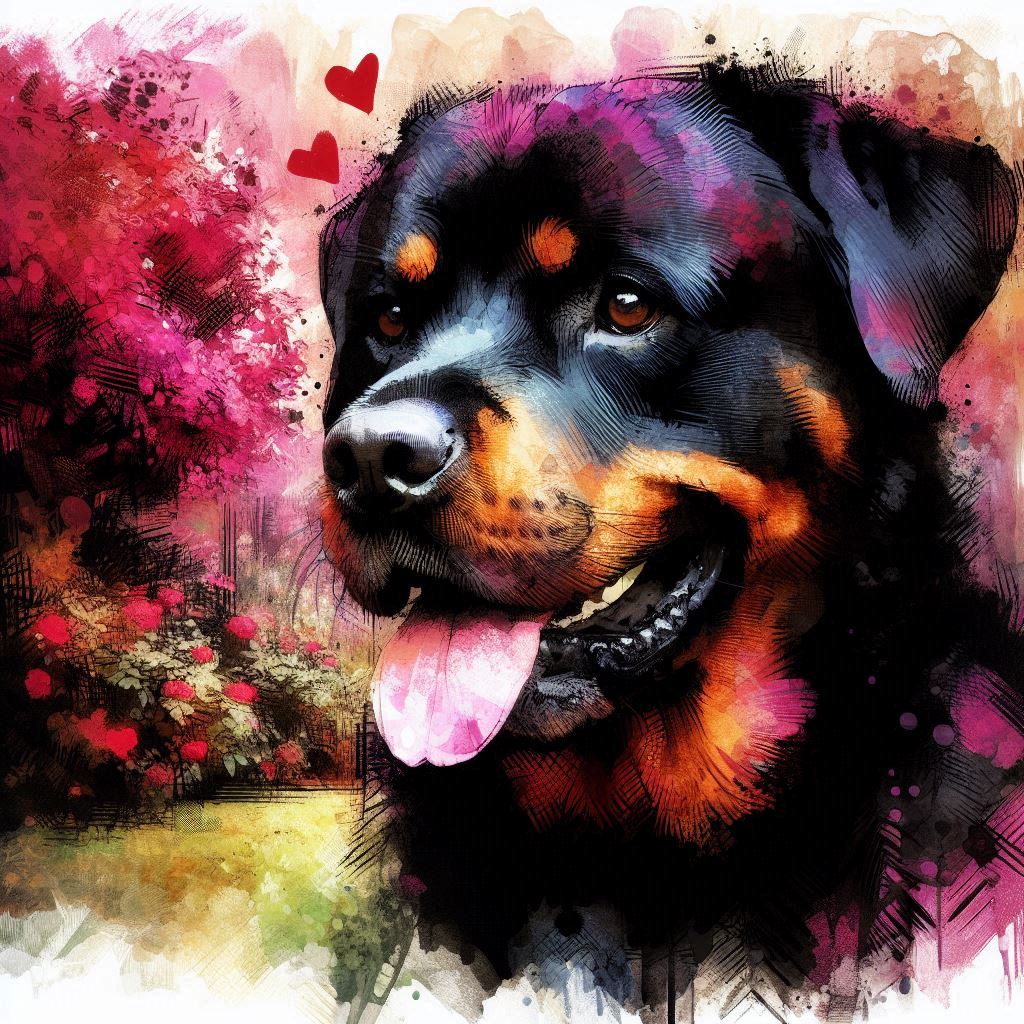
Kindness = Essential, Not Optional.
Yesterday we had a stressful day: Willem was at the vet for a CT scan. For that, he had to be put under anesthesia. Willem finds many medical procedures very stressful and is skeptical, but with patience, calmness, and trust (and a dollop of whipped cream), he allows himself to be treated just fine. Prior to this appointment, we had a very nice conversation with the vet to discuss Willem’s instructions. There was understanding, and a calm and friendly introduction was made. Fantastic!
Unfortunately, I see it happen every day on the street: unfriendly treatment of animals, dogs in this case.
They are often “trained” by the ‘laughing Mexican’ method. A little kick here, a yank there. They are often adorned with training tools that not only cause a lot of pain and discomfort but also fear. Or they are dragged along by an owner who is so busy with other things or in a hurry that the dog doesn’t even get a chance to calmly pee or poop. And so on, and so on…
It sometimes makes me really sad. I am certainly not perfect and undoubtedly make mistakes too, but my dogs are my friends, my family. And I treat them the way I like to be treated myself: with respect, calmness, love, and kindness.
P.S. Fortunately, my friend Willem is doing well.
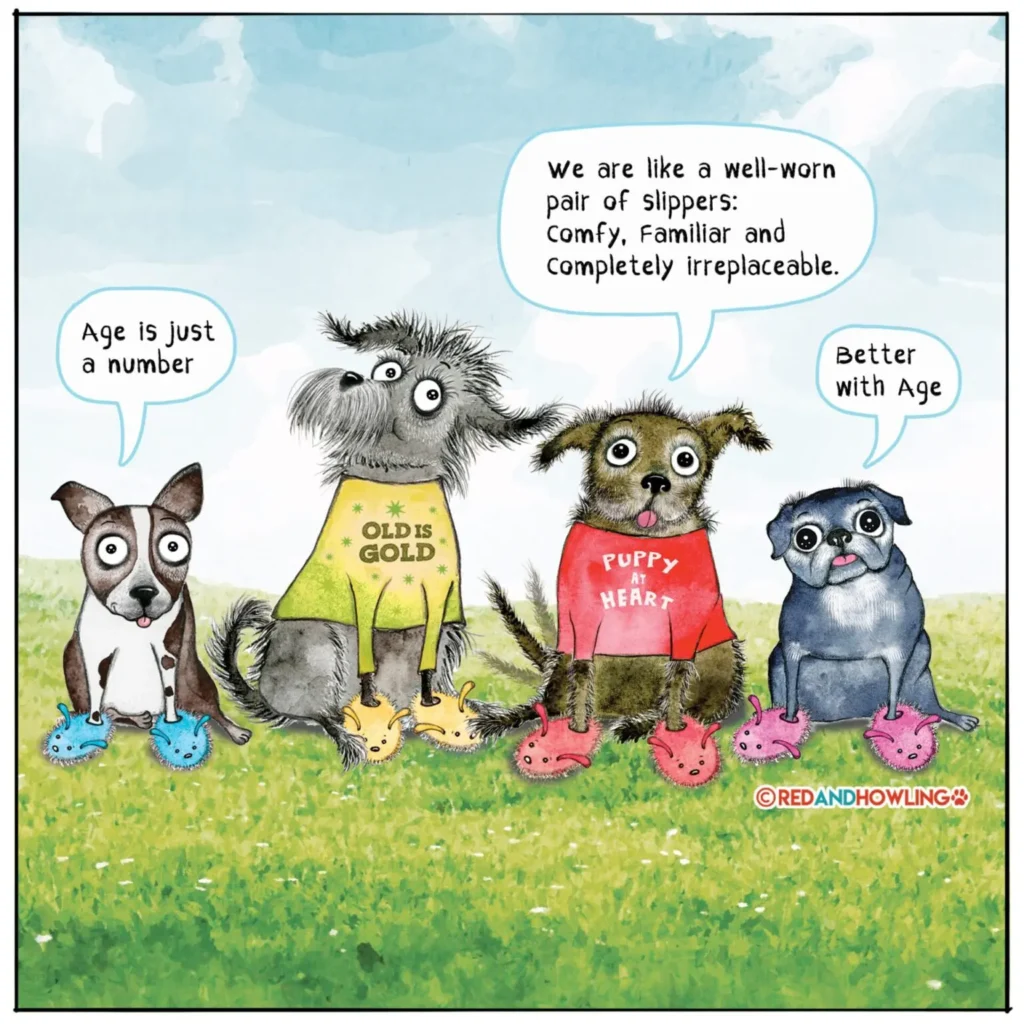
“I COULD NOT DO IT!”
“What are you going to do with such an old dog?” We often get these remarks thrown at us.
“Let them know they are wanted, loved, and very welcome” is always my answer. Nothing more, nothing less.
Over the years, we have had the opportunity to adopt several older girls and give them a wonderful time in the autumn of their lives.
Is it easy? No, not always. Sometimes with a laugh and sometimes with a tear. Every dog has its own history, its own story: from abuse, mutilation, being dumped, starvation, neglect, wandering life, years of being locked up in a cage, lack of (medical) care. But sometimes just the misfortune that, for example, their owner could no longer take care of them or had passed away.
We cannot turn back their history, but we can give them a “new” life through rest, space, routine, freedom, and good medical care.
And then you suddenly see the old dog bloom and almost transform back into a puppy.
And that’s why we do it!
What are you going to do with such an old dog? Just love them and enjoy spending time with them.
Maybe adopting a senior is something for you too, take a look at the seniors who are up for adoption.

GO ON, GO SEARCH!
I’ve noticed that the favorite command of visitors who enter the sniffing garden with their dog is still “SEARCH!”
The question that then comes to my mind is: WHAT should he/she search for? So I ask this question to the visitors and it often leads to interesting conversations.
A Sensory Garden is meant for sniffing, discovering, relaxing, and having fun. There are no objects or food hidden for a dog to find. However, there are many interesting scents that the dog’s nose will encounter. Along the way, the dog finds all sorts of things when he/she goes on a Sensory Garden adventure.
And what do we do? We only need to enjoy a dog working with his/her nose.
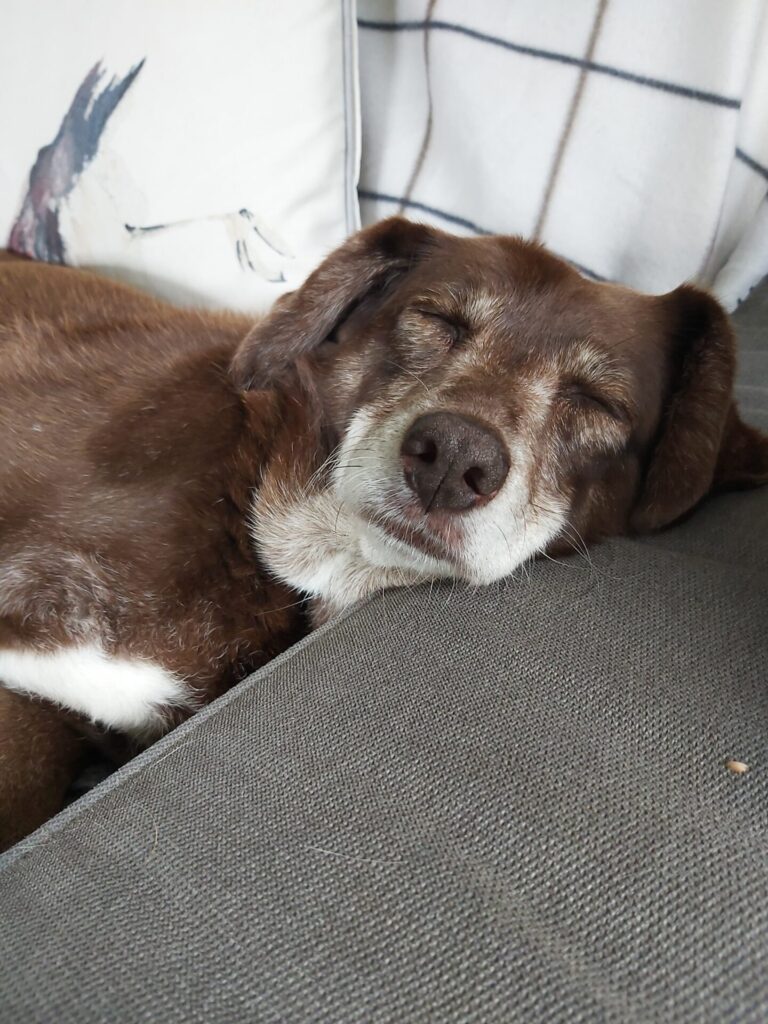
Are We Not Too Early?
Because we adopt 10+ dogs, the seniors, we always keep a close eye on their behavior and health. Important questions are:
A- Are they in pain and if so, can this be alleviated?
B- What is their quality of life?
Years ago, we came across Hugo Duijn’s booklet that beautifully expresses the reflections on putting an animal, that has been in “the final chapter” for some time, to sleep.
Yesterday, unfortunately, it was time for Elisa, completely unexpectedly. Yes, she was in pain, which couldn’t be alleviated, and the quality of life would be nearly nonexistent. So we had to make the difficult decision to let her go. It was a well-considered and the best decision, for her. Willem, OMA, and we ourselves are quite heartbroken. However, we are very glad that she was able to enjoy her well-deserved retirement here for over half a year with her two friends. And she did, full speed!
Yesterday, when I was working in the sniffing garden, I was able to take this beautiful picture of her, not knowing it would be the last. Her heart lay in the sniffing garden and sniffing around our property. Wonderful.
Safe travels, dearest Elisa!
Are We Not Too Early? By Hugo Duijn, veterinarian. – Farewell to a Pet
zijn we niet te vroeg? E-book
© 2021-2025 | All rights reserved

Congratulations!
Thirza and Patricia have passed the Specialisatie Buitenlandse Hond (Rescue Dog Specialization), the practice-oriented training.
As Rescue Dog Specialists, they can expertly guide owners with their rescue adopted dog.
Thirza takes the owner and dog into the great value of observing, resting, and discovering in her Snuffeltuin Sneupen at Willem.
Patricia will use her knowledge within her own company Dog-Ability, training & therapy, and as a driving force in the Stray Dogs Rescue foundation.
Both of them join our team of Buitenlandse Hond / Rescue Dog Specialists InZicht.
Source: FB page De Buitenlandse Hond, November 16, 2023
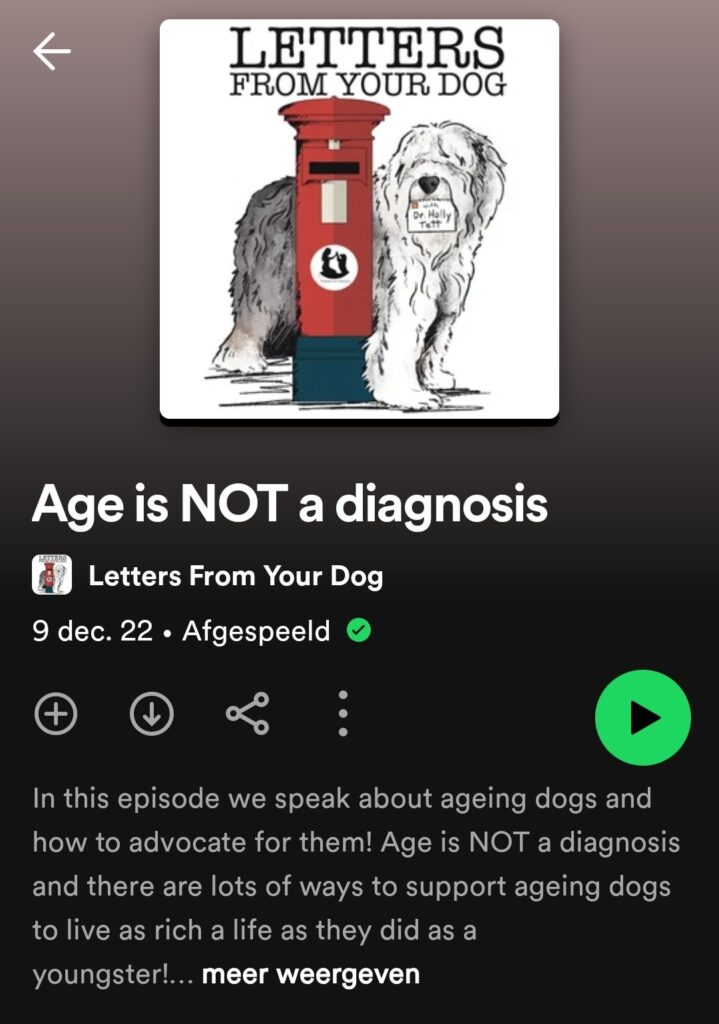
Recommendation:
Dr. Holly Tett (UK) has a large number of interesting podcasts about dogs on Spotify. I just listened to this one: Age is NOT a diagnosis.
Since we often adopt older dogs, and age unfortunately comes with certain issues, we are always alert to physical changes or changes in behavior. Luckily, we have a very good veterinarian who thinks along with us, even out-of-the-box.
Age is NOT a diagnosis.
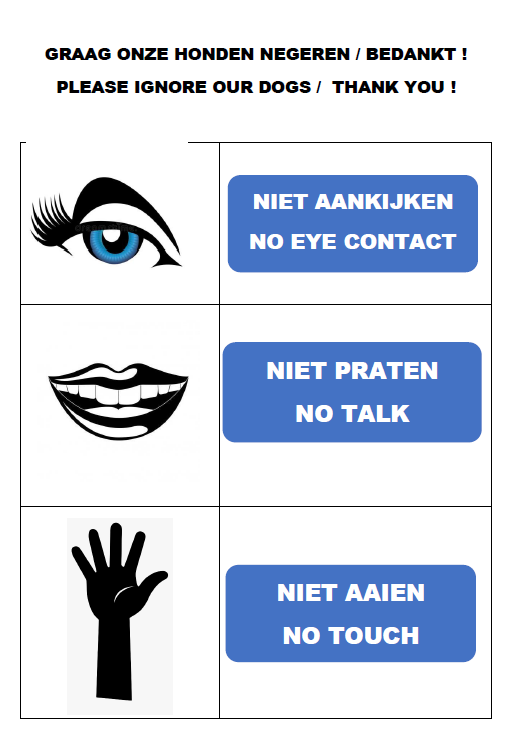
Please IGNORE my dogs, thank you!
Most people find it very difficult, don’t understand it, or worse, just don’t do it.
And then there goes the hand, full on the head, such a pity. Or when they are lying comfortably on the ground or in their basket, bending over and petting them anyway.
Please don’t, they don’t like it!
But a dog is to be petted, right? Look, he’s wagging his tail, isn’t he? And he jumps up nicely against me!
WILLEM is not a cuddler for strangers, but more of a “watch and wait” type. He does seek contact, but that does not immediately mean physical contact. No body contact please. But somehow he is very attractive to look deep into his eyes (yes, he is beautiful, I know), pet, drum on, hold tightly, or challenge to play. Don’t do that, he doesn’t like it. Oh, is he aggressive then? Never socialized?
Sigh…
Due to some negative experiences, he has become a bit more cautious and on guard. He sometimes gets stressed with new and especially busy people/meetings and then wants to be left alone. If not, he may sometimes start to grumble and then quickly run away.
Actually, he does that very neatly, just setting his boundaries.
OMA likes cuddles, but not immediately from strangers. And certainly not when people bend over to pet her full on the head.
She is small, cute to look at, wags friendly plus she has that upright ear, so really a petting magnet. That is quite a problem.
She also clearly sets her boundaries with someone who ignores my instructions: BITE!
Very good of her, but also a task for me. I must protect her in this.
Protect her from things she finds unpleasant.
So this homemade poster hangs at our door to make clear what I mean by ignoring. It works here.
Maybe it will be useful for you too. Feel free to share, download, and/or print.
Furthermore, if you plan to visit my sniffing garden and your dog finds new people a bit exciting, please indicate this on the contact form. Then I can take that into account.
© 2021-2025 | All rights reserved